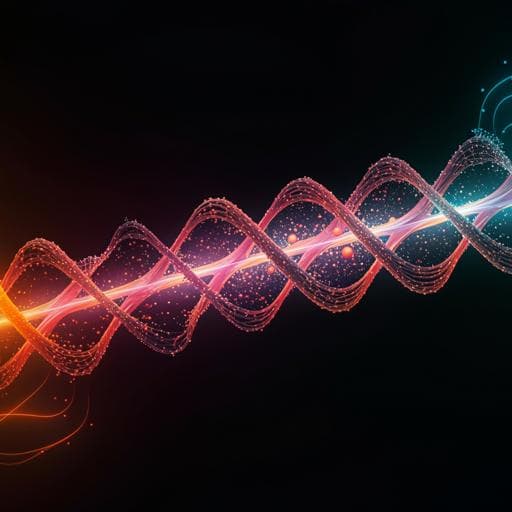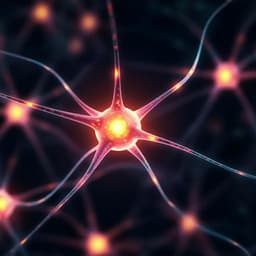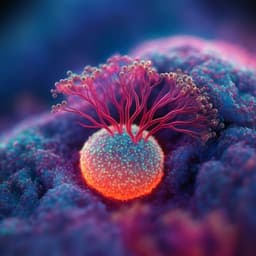
Medicine and Health
In vivo imaging of phosphocreatine with artificial neural networks
L. Chen, M. Schär, et al.
Discover how artificial neural network-based chemical exchange saturation transfer (ANNCEST) is revolutionizing the mapping of phosphocreatine concentration in human skeletal muscle. Conducted by Lin Chen and colleagues, this study showcases rapid and accurate quantification, achieving remarkable results in just 1.5 minutes with a 3T MRI scanner.
~3 min • Beginner • English
Introduction
The study addresses the need for a noninvasive, routine method to quantify and map phosphocreatine (PCr) in vivo with clinically relevant spatial resolution and scan times. PCr is essential for cellular energy buffering and is altered in neuromuscular and cardiovascular diseases. Although 31P magnetic resonance spectroscopy (MRS) is the established noninvasive method for measuring PCr and related metabolites, its low sensitivity leads to low spatial resolution and long acquisition times, and specialized hardware is required that is uncommon in clinical MRI settings. Chemical exchange saturation transfer (CEST) MRI can detect exchangeable protons without special hardware, but clinical translation is challenged by lower field strengths (1.5–3 T), reduced frequency separation, B0/B1 inhomogeneities, and confounding magnetization transfer contrast. The hypothesis is that an artificial neural network (ANN) trained on simulated and phantom Z-spectra can robustly and rapidly quantify PCr concentration, exchange rate, and field inhomogeneity parameters from CEST data acquired on standard 3T scanners, enabling high-quality PCr mapping in vivo and during exercise.
Literature Review
Prior work established 31P MRS for in vivo PCr, pH, and phosphate measurements, especially for exercise-recovery studies, but with limitations in spatial resolution and scan duration. High-field animal and preclinical studies showed PCr CEST peaks near 1.95 and 2.5 ppm and feasibility of CEST-based metabolite imaging; however, at clinical fields, peak separation and contrast diminish and magnetization transfer effects complicate quantification. Traditional CEST quantification methods (asymmetry analysis, Lorentzian fitting, rotating-frame relaxation) often assume linear superposition and require explicit B0/B1 mapping, which lengthens scans and may be less robust in vivo. Neural networks have demonstrated strong performance in medical imaging inverse problems and reconstruction tasks, motivating their use for CEST quantification to learn mappings from Z-spectra to physiological parameters without explicit fitting to complex Bloch–McConnell models.
Methodology
- ANN architecture and training: A fully connected feed-forward neural network with an input layer (Z-spectral intensities at specified offsets), seven hidden layers (sigmoid activation), and an output layer predicting metabolite concentration, exchange rate, B0 shift, and B1. Inputs/outputs normalized to [-1, 1]. Training used scaled conjugate gradient backpropagation with early stopping (80% train, 15% validation, 5% test), L2 regularization (regularization parameter 0.01), and stopping criteria on gradient, validation error, or epochs.
- Training data generation: Z-spectra simulated via Bloch–McConnell equations incorporating B0/B1 inhomogeneities and Gaussian noise. For phantom/numerical simulations: offsets 0.5–4 ppm (50 points), PCr peaks at 1.95 and 2.5 ppm (exchange rate ratio 1:2.19 measured at 37 °C), water T1/T2=2.6/1.8 s, PCr proton T1/T2=0.05/0.02 s, saturation 0.6 µT for 10 s; concentration 5–85 mM, exchange rate (1.95 ppm) 50–200 Hz, B0 −0.4–0.4 ppm; noise SD 0.0015; 1e5 spectra. For human in vivo training: offsets 1.3–3.5 ppm (50 points) with a single PCr peak at 2.5 ppm and an additional broad background pool representing MTC/other metabolites (8 M exchanging protons, exchange rate 30 Hz, T1=1 s, T2=9.1e−6 s, Super-Lorentzian lineshape). Water T1=1.2 s; water T2 varied 15–35 ms; PCr proton T1/T2=0.05/0.02 s; saturation 0.6 µT for 800 ms; concentration 0–100 mM, exchange rate 80–230 Hz, B0 −0.25–0.25 ppm, B1 0.5–0.7 µT; noise SD 0.0035; 1e5 spectra.
- Numerical validation: Ground-truth maps (256×256) for concentration, exchange rate (2.5 ppm), and B0 used to generate pixelwise Z-spectra. Performance compared to Bloch fitting initialized within parameter ranges; computational times recorded.
- Phantom MRI (3 T Bruker Biospec): PCr phantoms at 10, 20, 40, 60, 80 mM in PBS (pH 7.3). CEST: CW saturation 0.6 µT, 10 s; TSE readout (TR/TE 13 s/4.5 ms), slice 2 mm, matrix 32×32 (reconstructed 64×64), Z-offsets 0.5–4 ppm (0.1 ppm; 0.05 ppm between 1.5–3 ppm), S0 at 100 ppm. B0 via WASSR (−0.5 to 0.5 ppm), T1/T2 maps measured (IR and CPMG/TSE) to inform training.
- Human resting-state MRI (3 T Philips, 16-channel knee coil): Seven healthy subjects; FOV 160×160 mm2. Anatomy: T2w TSE at 0.63×0.63×5.0 mm3. PCr CEST: CW 0.6 µT, 800 ms; single-shot TSE readout TR 3.5 s, TE 3.7 ms, TSE factor 37, resolution 2.2×2.2×5.0 mm3; Z-offsets 1.3–3.5 ppm (52 incl. 2 S0 at 100 ppm); total scan 3 min. Reference B0 (dual-echo) and B1 (DREAM) acquired. CEST acquisition optimized by varying saturation power (0.2–0.8 µT) and length (0.4–1.0 s) using PLOF to maximize ΔZ at 2.5 ppm.
- Exercise study and 31P 2D MRS (3 T Philips; 2-channel 1H surface coil, 31P coil): Four healthy subjects performed in-magnet plantar flexion (16 lb, 1 Hz, 80 s) then 90 s hold; PCr recovery measured post-exercise. CEST: single-shot TSE TR 3 s, TE 9.3 ms, TSE factor 37, resolution 2.2×2.2×20 mm3; Z-offsets 1.3–3.5 ppm (30) plus S0; total 1.5 min per timepoint. 31P 2D MRS: TR 1.5 s, TE 1.44 ms; 60 measurements on 8×8 k-space, reconstructed 16×16, voxel 10×10 mm2, slice ~80 mm; total 1.5 min. Registration and downsampling used for voxelwise ANNCEST–MRS comparison across selected timepoints and regions.
- Quantification and comparisons: ANNCEST outputs PCr concentration, exchange rate, B0, B1 per voxel from Z-spectra. Compared against Bloch fitting, PLOF-derived concentration maps, and reference B0/B1 maps (dual-echo, DREAM). Correlation and Bland–Altman analyses performed versus ground truth (phantoms) and 31P MRS (in vivo). Robustness to water and PCr T1/T2 variation assessed via simulations.
Key Findings
- ANN performance and speed: ANNCEST accurately predicted concentration, exchange rate, and B0 from Z-spectra, outperforming Bloch fitting especially at low concentrations and for exchange rate/B1 estimation. Inference completed within ~2 s on a standard PC versus ~18 h for Bloch fitting on a cluster.
- Phantom validation (3 T): Strong correlation between predicted and ground-truth PCr concentration (R=0.9989). Predicted B0 map correlated with WASSR (R=0.9969). ANNCEST exchange rates consistent with inversion recovery measurements (260 ± 40 Hz mean ± SD).
- In vivo CEST optimization (3 T human muscle): Two peaks (1.95 and 2.5 ppm) visible at 0.2 µT; optimal PCr ΔZ at 2.5 ppm achieved with saturation power 0.6 µT and saturation length 800 ms. Higher powers diminished the 1.95 ppm peak due to MTC.
- High-quality PCr mapping in muscle: ANNCEST produced homogeneous concentration and exchange-rate maps robust to B0 (−0.15 to 0.25 ppm) and B1 (0.6–0.8 µT) inhomogeneities and MTC background, unlike PLOF which showed degradation in areas of B0/B1 variation. Mean PCr concentrations across five volunteers: GM 31.9 ± 2.0 mM, SOL 31.7 ± 3.3 mM, TA 30.8 ± 4.1 mM, P 30.9 ± 3.9 mM (consistent with literature 29–36 mM). Mean exchange rate across muscle: 164 ± 36.8 Hz (consistent with prior 140 ± 50 Hz).
- Reference map agreement: ANNCEST-derived B0 and B1 maps matched dual-echo and DREAM methods, respectively.
- Robustness to relaxation changes: Simulations showed minimal sensitivity of ANNCEST estimates over water T1 1.0–2.0 s (concentration change ~2.3 mM; exchange rate ~160 Hz stable) and water T2 15–50 ms; PCr proton T1/T2 variations similarly caused small changes.
- Exercise validation vs 31P 2D MRS: During plantar flexion, ANNCEST detected PCr depletion (e.g., ROI drop from 30.38 mM to 15.42 mM) and recovery consistent with 31P maps. Voxelwise correlation between ANNCEST and 31P 2D MRS across subjects and timepoints: R=0.813, p<0.001; Bland–Altman showed acceptable agreement.
- Acquisition efficiency: Clinical-quality PCr maps obtained within 1.5 min per CEST acquisition on standard 3T without specialized heteronuclear hardware; ANNCEST enables near real-time quantitative mapping.
Discussion
The findings demonstrate that ANNCEST can address the longstanding challenge of noninvasively mapping PCr with clinically practical spatial resolution and scan time. By learning the nonlinear mapping from Z-spectra to physiological parameters, ANNCEST circumvents explicit fitting to complex Bloch–McConnell models and mitigates the effects of B0/B1 inhomogeneities and MTC that often confound traditional CEST quantification. Optimal CEST parameters at 3 T (0.6 µT, 800 ms) emphasize the PCr-dominant 2.5 ppm peak, enabling robust estimation of concentration and exchange rate. The technique reproduced known resting PCr concentrations and exchange rates in human calf muscles and tracked dynamic exercise-induced depletion and recovery, agreeing well with 31P MRS. Robustness analyses indicate limited sensitivity to plausible ranges of water and PCr T1/T2 variations. Together, these results support the feasibility of ANNCEST as a fast, accurate, and widely accessible alternative to 31P MRS for assessing muscle energetics, with potential to generalize to other metabolites and tissues when appropriately trained.
Conclusion
ANNCEST enables rapid, high-spatial-resolution mapping of PCr concentration, exchange rate, and B0/B1 inhomogeneities from CEST MRI on standard 3 T clinical scanners, producing results consistent with phantoms, reference B0/B1 methods, literature values, and 31P MRS (R=0.813, p<0.001) within 1.5 minutes of acquisition and seconds of processing. This approach overcomes key barriers of traditional CEST quantification and 31P MRS, offering a cost-effective, widely deployable tool for studying muscle bioenergetics at rest and during exercise. Future work should improve temporal resolution (e.g., fewer offsets, accelerated CEST sequences), extend training to other metabolites and tissues, incorporate strategies to disentangle pH and temperature effects on exchange rate, and validate across broader populations and disease states.
Limitations
- Data-driven dependence: Accuracy relies on the representativeness of training data and model assumptions (e.g., background modeled as a single MTC pool). Generalization to other tissues/conditions may require retraining.
- Temporal resolution: Current dynamic acquisitions (~90 s temporal resolution) are insufficient for fine-grained kinetics; faster protocols are needed for detailed PCr dynamics.
- Parameter disentanglement: Exchange rate reflects combined effects of pH and temperature; ANNCEST currently cannot separate these contributions.
- B1 considerations: In phantoms, B1 homogeneity was assumed; scenarios with significant B1 variation may require broader spectral ranges or explicit B1 modeling in training.
- Residual confounds: Regions with vasculature and strong MTC may still impact quantification; careful choice of offsets and saturation parameters is required.
- Field strength constraints: At 3 T, reduced chemical shift separation compresses peaks; performance at 1.5 T or in other anatomical regions needs further validation.
Related Publications
Explore these studies to deepen your understanding of the subject.







